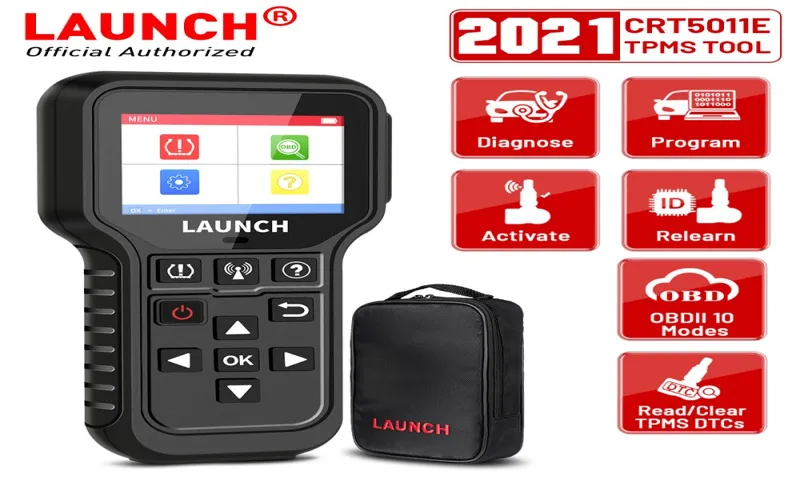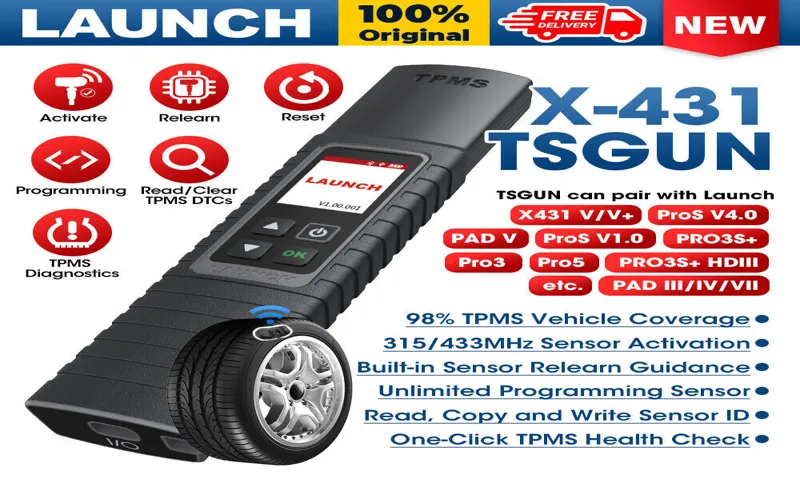Have you ever been driving down the road and the tire pressure light on your dashboard suddenly comes on? It’s an annoyance that every driver has experienced at some point. But did you know that you can actually reprogram your tire pressure sensors at home? This simple process can save you time and money in the long run. In this blog, we will provide an easy-to-follow guide on how to reprogram tire pressure sensors so you can get back on the road with confidence.
With just a few simple steps, you can reset your tire pressure sensors and avoid those pesky warning lights that can put a damper on your day. So if you’re tired of seeing that little light on your dashboard, keep reading to learn how to reprogram your tire pressure sensors like a pro.
Table of Contents
Understanding Tire Pressure Sensors
Reprogramming tire pressure sensors requires some knowledge of the process, but it can be done rather easily. Tire pressure sensors control and monitor the air pressure in your vehicle’s tires, alerting drivers if it becomes too low. When needed, the sensors can be reprogrammed to ensure that accurate tire pressure readings are being given.
This can be done by accessing the vehicle’s computer and using a specialized tool or by following the instructions in the vehicle’s owner’s manual. However, it’s important to seek professional help if you’re unsure about the process, as incorrect reprogramming can cause issues with the sensors’ functionality. By properly reprogramming tire pressure sensors, you can ensure your vehicle is operating at peak performance and staying safe on the road.
Types of Tire Pressure Sensors
Tire pressure sensors are becoming increasingly common in vehicles today. These sensors work by monitoring the air pressure in the tire and alerting the driver if the tire pressure drops below a safe level. There are two main types of tire pressure sensors: direct and indirect.
Direct tire pressure sensors use a sensor mounted inside the tire to measure the air pressure. Indirect tire pressure sensors, on the other hand, use the vehicle’s antilock brake system to determine if a tire is underinflated. Direct tire pressure sensors are more accurate and reliable than indirect sensors, but they can be more expensive to replace.
It’s important to understand the type of tire pressure sensors in your vehicle so you can properly maintain them and ensure they are functioning correctly. Keeping your tire pressure at the recommended level not only improves your vehicle’s performance and fuel efficiency, but it also ensures your safety on the road. So next time you’re checking your car’s tire pressure, remember to also check the type of sensor your vehicle uses.

Why Reprogram Tire Pressure Sensors?
Tire pressure sensors play a crucial role in ensuring safety while driving. They constantly monitor the pressure levels in your car’s tires, and warn you if the pressure is too high or too low. With such critical functions, it is essential to understand how they work and why reprogramming them is important.
Reprogramming the tire pressure sensors becomes necessary when you replace a tire or change their position on your car. The process of reprogramming involves resetting the sensors to recognize the new changes in tire position or pressure levels. Neglecting to reprogram sensors can render them ineffective in providing accurate readings.
It is akin to a compass without calibration; it won’t point you in the right direction. Therefore, it’s imperative to ensure that your sensors are reprogrammed after any change in tire position or replacement. Doing so will ensure that your tire pressure sensors continue to function correctly, giving you peace of mind as you drive on the road with a reliable safety mechanism.
Preparing to Reprogram Tire Pressure Sensors
Learning how to reprogram tire pressure sensors can save you time and money in the long run. Before attempting to reprogram your sensors, it’s essential to confirm that the sensors are compatible with the make and model of your vehicle. You should also know the correct tire pressure to set for your particular vehicle.
You can usually find this information in your car’s manual. Once you have checked compatibility and information for correct tire pressure, it’s time to begin the reprogramming process. Typically, this involves accessing the TPMS controls and following the instructions provided in your car manual or the manual that came with your sensors.
It’s important to note that the process may vary depending on the make and model of your vehicle. However, by following the manufacturer’s instructions, you should be able to successfully reprogram your tire pressure sensors without any issues.
Tools Required
Before reprogramming tire pressure sensors, there are a few tools you will need to ensure the process goes smoothly. Firstly, you will need a tire pressure monitoring system (TPMS) tool. This tool is essential for reprogramming the sensors and ensuring they communicate properly with your car’s onboard computer.
You can purchase these tools or consider borrowing/renting one from the local auto parts store. It’s also essential to have a stable power source, as the slightest interruption during reprogramming can cause errors. A fully charged vehicle battery is highly recommended.
Additionally, ensure that you have a clear and concise instruction manual and a compatible computer with the necessary software installed. Having these tools and resources at hand can help speed up the process and ensure accurate programming of your tire pressure sensors, providing peace of mind and improved safety on the road.
Locating the Tire Pressure Sensor Receiver
When it comes to reprogramming tire pressure sensors, the first step is to locate the sensor receiver. This receiver is located either behind the dashboard or in the trunk of the vehicle, depending on the make and model. Once you’ve located the receiver, make sure your tires are properly inflated and the ignition is turned on.
This will allow the sensor to pick up the tire pressure readings. From there, you can begin the reprogramming process. It’s important to note that not all vehicles can have their tire pressure sensors reprogrammed, and a professional mechanic may need to be consulted if you’re having difficulty locating the receiver or reprogramming the sensors.
With the right preparation and attention to detail, however, reprogramming your tire pressure sensors can be a simple and straightforward process.
Reprogramming Tire Pressure Sensors
If you’re wondering how to reprogram tire pressure sensors, you’re in the right place! It’s actually a fairly simple process that you can do yourself with the right tools and a bit of patience. The first step is to make sure you have the correct sensor codes for your particular vehicle. You can often find this information in your owner’s manual or by contacting your dealer or mechanic.
Once you have the codes, you’ll need a TPMS tool – a handheld device that can read and transmit data between your vehicle and the sensors. With the tool and codes in hand, you can then follow the specific instructions for your vehicle to reprogram the sensors. It’s important to note that proper tire pressure is key to keeping your vehicle safe and performing at its best.
Regularly checking and maintaining your tire pressure is an important part of vehicle maintenance and can help extend the life of your tires. So, take the time to learn how to reprogram your tire pressure sensors and keep your vehicle running smoothly.
Step-by-Step Guide
Reprogramming tire pressure sensors may seem like a daunting task, but it can actually be done relatively easily with a few simple steps. First, ensure that you have the correct tool for reprogramming your specific make and model of vehicle. This may be a TPMS tool or a scan tool depending on the manufacturer.
Once you have the correct tool, locate the TPMS button on your vehicle’s dashboard and press and hold it until the indicator light flashes. This will put your vehicle into reprogramming mode. Next, use the tool to activate each tire sensor in turn, starting with the left front tire and moving clockwise around the vehicle.
Once each sensor has been activated, the tool will beep or display a signal indicating that the sensor has been programmed. Finally, turn off the reprogramming mode on your vehicle by releasing the TPMS button. And that’s it! Your tire pressure sensors should now be reprogrammed and ready to go.
Don’t forget to check your tire pressure regularly to ensure optimal safety and performance on the road.
Common Issues and Troubleshooting
Reprogramming tire pressure sensors can be a tricky task, but there are a few common issues and troubleshooting techniques that can help. One issue that many people face is a tire pressure sensor that won’t reset or reprogram. If this happens, the first thing to check is the battery in the sensor.
When the battery goes dead, the sensor won’t communicate with the car’s computer, and it won’t be able to be programmed. Another issue that some people face is that the tire pressure sensor won’t communicate with the tool used to reprogram it. In this case, it’s important to make sure that the tool is compatible with the particular sensor that needs to be programmed.
It’s also important to make sure that the sensor is properly positioned and that the tool is being used correctly. With a little troubleshooting, these issues can be overcome, and the tire pressure sensor can be reprogrammed to keep you safe on the road.
Maintaining Reprogrammed Tire Pressure Sensors
Reprogramming tire pressure sensors is a valuable skill that can save you both time and money. However, it is important to maintain these sensors to ensure they continue to function properly. One way to do this is by regularly checking the battery life of your sensors.
Most sensors are designed to last about five to ten years, but this can vary based on how frequently you drive your car. If the battery is low, make sure to replace it as soon as possible to avoid any malfunctions. Another crucial step is to calibrate your sensors at least once a year.
This involves resetting the sensor to your desired pressure levels and ensuring that they are accurate. Lastly, it is important to keep your sensors clean and free of debris. This prevents any interference with the signal and helps them function optimally.
By following these tips, you can maintain your reprogrammed tire pressure sensors and ensure a safe and enjoyable driving experience.
Regular Sensor Maintenance
Regular Sensor Maintenance Maintaining reprogrammed tire pressure sensors is crucial for ensuring optimal vehicle performance and safety. Regular sensor maintenance involves various steps, including checking the sensor’s battery life, updating the sensor’s software, and keeping the sensor clean. The battery life of a tire pressure sensor usually lasts up to 10 years, but it’s essential to check the battery’s life to ensure it’s not draining out anytime soon.
Sensor software updates are necessary to keep up with technological advancements and vehicle updates. Lastly, keeping the sensor clean is vital in the prevention of damage and interference with other sensors. Neglecting regular maintenance of tire pressure sensors can lead to inaccurate readings, which can result in decreased fuel economy, increased tire wear, and ultimately compromise safety on the road.
So, make sure to maintain your reprogrammed tire pressure sensors regularly to promote optimal vehicle performance and safety on the road.
When to Reprogram Your Sensors Again?
Tire Pressure Sensor Maintenance Reprogramming tire pressure sensors is an effective way to ensure your vehicle maintains perfect tire pressure. However, like all sensors, tire pressure sensors need maintenance to remain accurate. The right time to reprogram your sensor again depends on the sensor’s quality and the driving conditions.
When you notice your tire pressure sensor giving irregular readings or displaying an incorrect PSI, you should consider reprogramming it. Additionally, if you live in an area with extreme temperatures or rough terrain, sensors may require frequent checks and reprogramming. Proper maintenance of your tire pressure sensors will not only ensure the correct tire pressure reading but also prolong the life of your car tires.
So, keep an eye on the sensor readings and reprogram them as required and give your tires the best chance of a long life.
Conclusion
In conclusion, reprogramming tire pressure sensors may seem like a daunting task, but with the right tools and a little bit of know-how, it’s a breeze. So don’t let those pesky warning lights keep you up at night – take charge of your tire pressure sensors and keep your ride smooth and safe. Just remember, while you may be reprogramming the sensors, you can’t reprogram the laws of physics – so always make sure to keep your tires properly inflated to ensure optimal performance and efficiency.
Happy reprogramming!”
FAQs
What are tire pressure sensors, and why do they need to be reprogrammed?
Tire pressure sensors are devices that monitor the air pressure in a vehicle’s tires. They need to be reprogrammed in case of replacement or when the current settings are incorrect.
Can I reprogram tire pressure sensors myself, or do I need to take them to a mechanic?
It depends on the make and model of your vehicle. Some models allow drivers to reprogram tire pressure sensors through a few simple steps, while others require a mechanic’s expertise.
How often should I reprogram my tire pressure sensors?
There is no hard and fast rule, but it is recommended to reprogram them every time you replace your tires or if you notice any abnormal readings.
What tools do I need to reprogram tire pressure sensors?
Depending on the make and model of your vehicle, you may need a professional-grade tire pressure monitor tool or a device that connects with your car’s computer system.
Will my car’s warranty be affected if I reprogram tire pressure sensors myself?
It depends on the terms and conditions of your manufacturer’s warranty. Check the documentation to know if reprogramming tire pressure sensors is allowed or not.
What happens if I don’t reprogram my tire pressure sensors?
If your tire pressure sensors are not reprogrammed when they need to be, they might offer inaccurate readings, leading to poor performance or safety risks.
How much does it cost to reprogram tire pressure sensors with a mechanic?
The cost of hiring a mechanic for reprogramming tire pressure sensors varies. Factors like location and the make/model of your car are some things that determine the cost.



